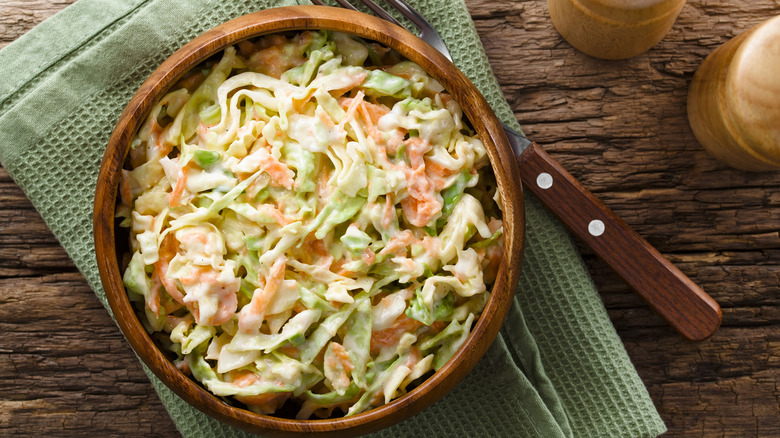How Long Does Coleslaw Last Out Of The Fridge?
With its tangy flavor and crispy texture, coleslaw can be a refreshing addition to most meals. You can serve it with tacos, pulled pork, barbecue foods, sandwiches, rice, and everything in between. Plus, it's extremely versatile and can be prepared in a multitude of ways. For example, Germans usually eat krautsalat, a type of coleslaw made with raw cabbage, onions, vinegar, and oil. On the other hand, Americans usually mix cabbage with mayonnaise, vinegar, lemon juice, carrots, honey, and other ingredients. Some people even make coleslaw with pickled raisins, avocado, pineapple, or nuts. How long your coleslaw lasts out of the fridge will depend on the recipe you use.
In the U.S., most coleslaw recipes call for Greek yogurt, mayo, sour cream, and other foods with a short shelf life. For this reason, coleslaw should be stored in an airtight container in the refrigerator and served within three to five days. Another option is to freeze it, but you'll have to leave the mayo out and add it before serving.
If you're expecting guests, you should still refrigerate the coleslaw until they arrive. Unlike kimchi and sauerkraut, this tangy salad doesn't do well at room temperature and can go bad within hours.
How long can you leave coleslaw out before it goes bad?
Like most salads, coleslaw has a short shelf life and shouldn't be left out of the fridge for longer than two hours. Ideally, keep it out for one hour or less if you're eating outdoors on a hot summer day. A study conducted in 1976 found that refrigerating coleslaw at 33.8 degrees Fahrenheit prevented bacterial growth, according to the journal "Applied and Environmental Microbiology." But even so, the lactic bacteria in the cabbage died and were replaced by those in the sour cream. When the coleslaw was stored at 44 degrees Fahrenheit, researchers noticed significant changes in its taste, odor, and color, even in the absence of pathogenic bacteria.
These findings indicate that cabbage can deteriorate rapidly when stored at room temperature. Vinegar and other acidic ingredients may slow bacterial growth, but they cannot prevent plant tissue breakdown. Additionally, coleslaw often contains mayo or dairy-based dressings that can go bad pretty quickly.
The U.S. Department of Agriculture warns that bacteria thrive at temperatures between 40 and 140 degrees Fahrenheit, so the longer you leave your food out, the higher the risk of spoilage. If you're having a picnic, store the coleslaw in a cooler or pack it with ice. Alternatively, transfer it to an airtight container and place it in a bag with frozen water bottles.
Coleslaw has a short shelf life, but you can keep it fresh longer
Some foods last forever, but coleslaw isn't one of them. Your best bet is to serve it immediately or refrigerate it for no longer than five days. When in doubt, err on the side of caution and discard any leftovers that have been left out in the open for hours. Meanwhile, there are a couple of things you can do to keep this food fresh longer.
First of all, consider using vinegar-based dressings instead of mayo or sour cream. For example, this Asian coleslaw recipe calls for agave syrup, rice vinegar, toasted sesame oil, soy sauce, and other ingredients. The salt in soy sauce, as well as the vinegar and agave syrup, act as preservatives. Better yet, refrigerate the coleslaw and add the dressing just before serving. This will prevent the cabbage from getting soggy and help to maintain its crunchiness.
Ideally, prepare the ingredients ahead of time and keep them separately until before serving. Shred the cabbage and store it in an airtight container, then chop the other vegetables and store them separately. Likewise, prepare the dressing and refrigerate it in a separate container. Mix all the ingredients when you're ready to eat. Go one step further and salt the cabbage beforehand. Let it rest for at least one hour, and then rinse it with water. Refrigerate the shredded cabbage and mix it with the other ingredients at mealtime.


